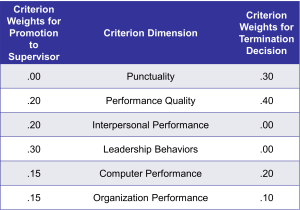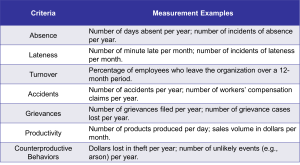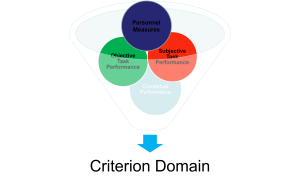6-3: The Criterion Domain
 The Criterion Domain: Multiple Versus Composite Approaches
The Criterion Domain: Multiple Versus Composite Approaches
Here’s a question that might keep performance measurement experts up at night: should we treat performance as one big thing or lots of little things? A fundamental issue in criterion measurement involves whether to treat performance as a unidimensional construct that can be represented by a single overall score or as a multidimensional phenomenon requiring separate measurement of distinct performance components.
This challenge, identified by Flanagan (1956) and comprehensively reviewed by Austin and Villanova (1992) as “the criterion problem,” has remained central to industrial psychology for decades. The classic industrial psychology perspective historically viewed performance as a singular, unidimensional construct that could be adequately represented by a single criterion measure. This approach simplified decision-making by providing a single performance index for each individual. However, contemporary research overwhelmingly supports the multidimensional view of performance, recognizing that different performance aspects may be relatively independent and require separate consideration.

Venkatraman and Ramanujam (1986) argued that organizational performance measurement requires sophisticated approaches that can capture multiple, potentially conflicting dimensions while maintaining decision-making utility. The multidimensional perspective creates challenges for organizational decision-making, particularly in selection contexts where hire-versus-reject decisions require some form of overall evaluation. If performance is multidimensional, how do we make organizational decisions? If there are multiple components, which do we use to make decisions such as hire/don’t hire?
Composite criteria address this challenge by creating weighted combinations of multiple performance dimensions that result in single performance indices. The development of composite criteria raises complex questions about how to weight different performance dimensions. Should all dimensions receive equal weight, or should some aspects be considered more important than others? Weight allocation should ideally reflect organizational goals and empirical research on the relative importance of different performance aspects for organizational effectiveness.

Research by Luthans and colleagues (2007) demonstrated that composite measures combining multiple performance dimensions (such as hope, resilience, optimism, and efficacy) often provide better prediction of overall performance and satisfaction than individual component measures alone. Their findings support the utility of composite approaches while highlighting the complexity of determining appropriate weighting schemes.

Consider combining criterion dimensions for an administrative assistant position. If oral communication, procedural knowledge, and client interactions each receive weights of .30, while typing speed receives a weight of .10, the composite score emphasizes interpersonal and knowledge-based performance over purely technical skills. This unequal weighting of criteria dimensions should be based on value judgments made from organizational goals and research.
While composite criteria enable straightforward organizational decisions, they may obscure important information about specific performance strengths and weaknesses. An individual might excel in some performance areas while struggling in others, information that becomes lost in overall composite scores. But what is the construct now? Organizations must balance the decision-making utility of composite criteria against the diagnostic value of maintaining separate performance dimensions.
Future Directions and Emerging Trends
So where is all this heading? Criterion measurement continues to evolve in response to changing work environments, technological advances, and improved understanding of workplace performance. Several trends are shaping the future of performance measurement and criterion development.
Technology integration enables new approaches to performance measurement including real-time data collection, automated performance monitoring, and sophisticated analytics that can identify performance patterns not apparent through traditional measurement methods. These advances may improve measurement accuracy while reducing administrative burden.
Big data approaches use large datasets to identify relationships between various organizational metrics and performance outcomes. Machine learning techniques may reveal complex patterns that inform criterion development and help organizations understand the full range of factors that contribute to effectiveness.
Remote work considerations have become increasingly important as organizations adapt to distributed workforces. Traditional performance measures may not adequately capture effectiveness in virtual work environments, requiring new approaches to criterion measurement that reflect the realities of remote collaboration and productivity.
Diversity, equity, and inclusion initiatives are driving examination of whether traditional performance criteria adequately reflect the contributions of all employees or systematically advantage certain groups. Organizations are exploring how to measure performance in ways that recognize diverse approaches to effectiveness and avoid cultural bias.
Continuous performance management approaches replace annual performance reviews with ongoing feedback and measurement systems. These approaches require different criterion measurement strategies that can support regular performance conversations and development activities.
Team-based performance measurement becomes increasingly important as work becomes more collaborative and interdependent. Traditional individual-focused criteria may not adequately capture contributions to team effectiveness or account for the collective nature of many work outcomes.
As Miller and Salkind (2002) note in their comprehensive handbook, the evolution of measurement approaches must balance methodological rigor with practical applicability in organizational settings.
Emerging Innovations in Criterion Measurement
As organizations continue to evolve in the digital age, new technologies are transforming how employee performance is measured. These innovations offer exciting opportunities for real-time insights and continuous improvement, but they also raise important practical and ethical challenges.
Real-time performance analytics represent one of the most significant developments in modern criterion measurement. These systems integrate data from various sources—such as project management tools, communication platforms, and productivity software—to provide dynamic dashboards that track key performance indicators. For example, sales teams may use real-time dashboards to monitor call volume, conversion rates, and customer satisfaction scores. These tools enable managers to identify performance trends early, provide timely feedback, and make data-driven decisions. However, implementing real-time analytics requires robust data infrastructure and careful calibration to ensure that metrics accurately reflect meaningful performance.
Wearable technology for behavioral tracking is being explored as a tool for capturing performance-related data in the workplace. These devices can monitor physical activity, stress levels, sleep patterns, and even social interactions through proximity sensors. In high-risk environments like manufacturing or logistics, wearables can detect fatigue or unsafe movements, helping prevent accidents. In office settings, they may provide insights into employee well-being and collaboration patterns. While promising, wearable tech must be deployed with transparency and consent, and organizations must ensure that data collection aligns with job relevance and privacy standards.
The shift toward continuous performance monitoring introduces significant ethical considerations that organizations can’t ignore. Employees may perceive constant surveillance as intrusive, leading to stress, reduced trust, and lower job satisfaction. To address these concerns, organizations must establish clear policies outlining what data is collected, how it’s used, and who has access. Involving employees in the design and implementation of monitoring systems can enhance acceptance and ensure fairness. Additionally, organizations should prioritize data minimization—collecting only what’s necessary—and regularly audit systems for bias and unintended consequences.
When implemented thoughtfully, these emerging innovations in criterion measurement offer powerful tools for enhancing organizational effectiveness. Real-time analytics and wearable technologies can support timely feedback, proactive interventions, and improved performance outcomes. However, success depends on balancing technological capabilities with ethical responsibility, employee engagement, and a commitment to fairness and transparency.
Conclusion
If you’ve made it this far, congratulations! You’ve just traveled through one of the most challenging yet essential aspects of industrial psychology. Criterion measurement represents the foundation that underlies virtually every important decision organizations make about their people—from who gets hired to who gets promoted to how performance is evaluated and rewarded.
You’ve learned that measuring job performance is far more complex than it initially appears. What seems like a simple question—”How well is someone doing their job?”—actually involves sophisticated theoretical frameworks, careful attention to psychometric properties, and thoughtful consideration of legal and ethical implications.
The evolution from narrow task-focused performance measures to comprehensive models that include contextual performance, organizational citizenship behaviors, and counterproductive work behaviors reflects our improved understanding of the full range of workplace contributions that affect organizational effectiveness. This broader perspective enables more complete assessment of individual performance while supporting organizational goals for productivity, cooperation, and positive work environments.
Contemporary challenges in criterion measurement include adapting to changing work environments, incorporating technological advances, and ensuring fairness across diverse employee populations. Organizations that invest in high-quality criterion measurement systems gain significant advantages through improved performance management, better selection decisions, and enhanced organizational effectiveness.
The field continues to advance through integration of multiple measurement approaches, technology-enhanced data collection, and sophisticated analytical techniques that reveal complex relationships between individual characteristics and performance outcomes. Future developments will likely emphasize real-time performance monitoring, team-based measurement approaches, and systems that support continuous performance improvement rather than periodic evaluation.
The fundamental challenge of accurately measuring human performance will continue to drive innovation in criterion development and application. Success in this endeavor requires ongoing attention to theoretical foundations, psychometric principles, legal requirements, and practical implementation considerations that ensure criterion measurement systems serve both individual and organizational goals effectively.
Whether you’re a future HR professional, manager, or simply someone who wants to understand how workplace decisions are made, this knowledge will serve you well. The next time you’re in a performance review or wondering why certain selection decisions were made, you’ll have the insight to understand the complex science behind these seemingly simple workplace activities.
Media Attributions
- Exam © Unknown is licensed under a Public Domain license
- Composite Criterion
- Objective Criteria
- Criterion Domain © Jay Brown
